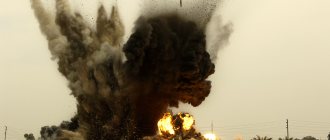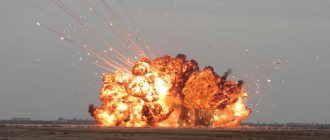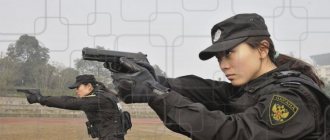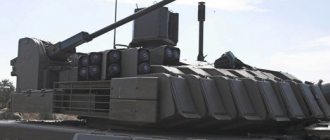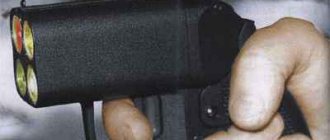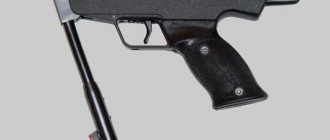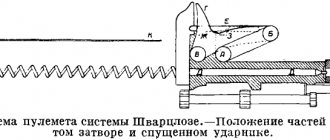Physicochemical and toxic properties
Tabun (cyanophosphorus ethyl ester dimethylamide) is a slightly brownish liquid with a fruity odor (fishy in high concentrations), melting point -50°, boiling point approx. 230°. Volatility 0.6 mg/l at t° 20°, vapor density in air 5.6; beat weight 1.08. Tabun is poorly soluble in water (12% at t° 20°), well soluble in alcohol, organic solvents, fuels and lubricants, penetrates paint coatings and rubber products, and is less toxic compared to other nerve agents. Absolutely lethal concentrations of tabun during inhalation exposure: 0.25-0.3 mg/l with an exposure of 15 minutes. or 2.0 mg/l with exposure 30 seconds; DL50 of tabun when ingested with water or food - 5 mg/kg, when penetrated through the skin - 50 mg/kg (dogs). According to foreign experts, herd has lost its military significance, but is one of the well-studied organophosphorus substances.
Sarin (isopropyl methyl fluorophosphonate) is a colorless liquid with a very faint fruity odor, melting point -54°, boiling point 147°. Volatility 12.1 mg/l at 20°; vapor density in air 4.8; beat weight 1.09. Sarin dissolves well in water, alcohol, organic solvents, and is absorbed into painted and porous surfaces, as well as into rubber products. Sarin vapors are easily adsorbed by various materials (textiles, wood, etc.). As a result of subsequent desorption, high concentrations of its vapors can be created in the air. In summer, under appropriate meteorological conditions, sarin remains on the ground in liquid form for up to 4-5 hours; its vapors have a damaging effect throughout the day. In winter conditions, sarin remains in the area for up to 2 days. Sarin is about 10 times more toxic than tabun.
Soman (pinacoline methyl fluorophosphonate) is a colorless liquid (transparent) with an aromatic camphor odor, melting point -80°, boiling point 185-187° (with decomposition). Volatility 3 mg/l at 20°; vapor density in air 6.3; beat weight 1.01. Poorly soluble in water. It dissolves well in organic solvents. Easily absorbed into paint and varnish coatings, porous materials, rubber products. More persistent than sarin. When exposed to inhalation, it is 2-3 times more toxic than sarin, and when exposed through the skin in droplet-liquid form, it is 15-20 times more toxic.
V-gases include chemically similar ones. structure of compounds containing an aminothiol group (phosphorylthiocholines). These are colorless liquids (or crystalline solids) with a melting point of -40°, a boiling point of 300°. Volatility 0.003-0.018 mg/l at t° 20°; vapor density in air 7.4; beat weight 1.07. V-gases are poorly soluble in water (1-5% at t° 20°) and are resistant to hydrolysis. They dissolve well in organic liquids. Due to low volatility, they can be used in the form of aerosols.
Objects contaminated with V-gases pose a danger for many days and even weeks. V-gases are more toxic than soman.
Nerve gases: history of creation
The official date of the appearance of chemical weapons is April 15, 1915 - the day of the memorable German gas attack on the French. However, attempts to use gases to defeat the enemy were made long before this date. They are described in ancient Chinese chronicles; ancient Greek historians reported on the use of gases during the Peloponnesian War; they repeatedly tried to use poisonous substances in the Middle Ages. However, the low level of development of technology (primarily, of course, chemistry) did not allow the creation of truly effective chemical weapons.
The situation changed dramatically at the end of the 19th century. The rapid development of the chemical industry made it possible to begin work on the creation of chemical warfare agents. They started in several countries at once: in the UK, Russia and Germany. The Teutons managed to achieve the most impressive results, which they “brilliantly” proved during the First World War.
The chemical agents that were used during this conflict are today classified as first-generation chemical weapons. Here are their main groups:
- General toxic agent (hydrocyanic acid);
- Agents of blister action (mustard gas, lewisite);
- Asphyxiating agents (phosgene, diphosgene);
- Irritating agents (for example, chloropicrin).
During WWI, about 1 million people suffered from chemical weapons, and hundreds of thousands of people died.
After the end of WWII, work in the field of improving chemical weapons continued, and deadly arsenals continued to be replenished. The military had little doubt that the next war would also be a chemical war.
In the 1930s, work began in several countries on the creation of chemical weapons based on organophosphorus substances. In Germany, a group of scientists worked on the creation of new types of pesticides, led by Dr. Schrader. In 1936, he managed to synthesize a new organophosphorus insecticide, which was extremely effective. The substance was called herd. However, it soon became clear that it is perfect not only for exterminating pests, but also for mass persecution of people. Subsequent developments were already underway under the patronage of the military.
In 1938, an even more toxic substance was obtained - isopropyl ester of methyl fluorophosphonic acid. It was named after the first letters of the names of the scientists who synthesized it - sarin. This gas turned out to be ten times more deadly than the herd. Soman, the pinacolyl ester of methyl fluorophosphonic acid, became even more toxic and persistent; it was obtained a few years later. The last substance in this series, cyclosarin, was synthesized in 1944 and is considered the most dangerous of them. Sarin, soman, and V-gases are considered to be second-generation chemical weapons.
After the end of the war, work on improving nerve gases continued. In the 50s, V-gases were first synthesized, which are several times more toxic than sarin, soman and tabun. For the first time, V-gases (they are also called VX-gases) were synthesized in Sweden, but very soon Soviet chemists managed to obtain them.
In the 60-70s, the development of third-generation chemical weapons began. This group includes toxic substances with an unexpected mechanism of attack and toxicity that is even greater than nerve gases. In addition, in the post-war years, much attention was paid to improving the means of delivering chemical agents. During this period, the Soviet Union and the United States began developing binary chemical weapons. This is a type of toxic substance, the use of which is possible only after mixing two relatively harmless components (precursors). The development of binary gases greatly simplifies the production of chemical weapons and makes international control of their proliferation virtually impossible.
Since the first use of combat gases, work has constantly been going on to improve means of protection against chemical weapons. And significant results have been achieved in this area. Therefore, at present, the use of chemical agents against regular troops will not be as effective as during the First World War. It is a completely different matter if chemical weapons are used against civilians, in which case the results are truly frightening. The Bolsheviks liked to carry out similar attacks during the Civil War, in the mid-thirties the Italians used military gases in Ethiopia, in the late 80s the Iraqi dictator Saddam Hussein poisoned rebel Kurds with nerve gases, fanatics from the Aum Senrikyo sect sprayed sarin in the Tokyo subway.
The latest cases of chemical weapons use are related to the civil conflict in Syria. Since 2011, government forces and the opposition have constantly accused each other of using chemical agents. On April 4, 2022, as a result of a chemical attack in the village of Khan Sheikhoun, in northwestern Syria, about a hundred people were killed and almost six hundred were poisoned. Experts said the attack was carried out using the nerve gas sarin and blamed government forces. Photos of Syrian children poisoned by gas spread throughout the world's media.
Mechanism of action
The toxicity of nerve agents is primarily due to their anticholinesterase action (see Anticholinesterase agents). This is confirmed by the presence of a close correlation between the degree of inhibition of cholinesterase activity and the accumulation of acetylcholine, on the one hand, and the severity of intoxication, on the other. Nerve agents inhibit AChE (true cholinesterase), located mainly in nervous tissue, and butyrylcholinesterase (false cholinesterase), which is located in Ch. arr. in blood plasma. The leading role in the manifestation of the toxic effect of nerve agents is the inhibition of AChE, which results in excessive accumulation of acetylcholine, which has muscarine- and nicotine-like effects, in the cholinergic synapses of the central and peripheral nervous system. As a result of this, a wedge develops, manifestations characteristic of poisoning with muscarine (see) and nicotine (see). Along with the anticholinesterase effect in high concentrations, nerve agents also affect cholinergic receptors. These effects lead to disruption of synaptic transmission (cholinomimetic and cholinosensitizing effects of OM). The accumulation of acetylcholine in the body contributes to a significant release of steroid hormones, adrenaline, norepinephrine and other biologically active substances (histamine, serotonin, glycine, GABA) into the blood. At the same time, some of them (histamine, serotonin) enhance, while others (adrenaline, steroid hormones, glycine, GABA) weaken the toxic effect of acetylcholine.
Thus, the clinical manifestations of intoxication with nerve agents depend both on the degree of inhibition of cholinesterase activity and on their direct effect on cholinergic receptors, as well as the combined and opposite effects of other biologically active substances.
Physiological action[edit]
Sarin is a poisonous substance with a nerve-paralytic effect. Causes damage with any type of exposure, especially quickly with inhalation. The first signs of damage (miosis and difficulty breathing) appear when the concentration of sarin in the air is 0.0005 mg/l (after 2 minutes). Lethal concentration when exposed through the respiratory system for 1 minute - 0.075 mg/l, when exposed through the skin - 0.12 mg/l. The semi-lethal dose (at which 50% of individuals die) upon contact with open skin is 24 mg/kg body weight. The semi-lethal dose for oral administration is 0.14 mg/kg body weight.
Mechanism of actionedit
As with other nerve agents, sarin targets the body's nervous system.
When motor and autonomic neurons are stimulated, the neurotransmitter acetylcholine is released into the intersynaptic space of the synapse, thereby transmitting an impulse to a muscle or organ. In a physiologically healthy body, after impulse transmission, acetylcholine is utilized by the enzyme acetylcholinesterase (AChE), as a result of which impulse transmission stops.
Sarin irreversibly inhibits the enzyme acetylcholinesterase by forming a covalent compound at the site of the enzyme where acetylcholine is hydrolyzed. As a result, the content of acetylcholine in the intersynaptic space is constantly growing, and impulses are continuously transmitted, maintaining all organs innervated by the autonomic and motor nerves in an active state (state of secretion or tension) until their complete exhaustion.
Clinic of the lesion
Nerve agents penetrate the body through the respiratory system, skin, and gland. tract and wound surfaces. In the wedge, the picture of intoxication with nerve agents, general and local effects are distinguished. As a rule, the development of typical symptoms of poisoning is preceded by a latent period, the duration of which is determined by the type and amount of the agent that has entered the body, as well as the place of application of the poison. It can last from several minutes to several hours. The longest latent period is with cutaneous applications of the agent. As a result of the resorption of OM, after the latent period, the general effect of poisons appears, characterized by various dysfunctions of the c. n. pp., respiration, blood circulation, digestive system, kidneys, etc.
Depending on the amount of poison that enters the body, poisoning can be mild, moderate or severe.
In mild cases of poisoning, those affected are excited, irritable, and restless. Individual symptoms of intoxication predominate in them. In cases of contact with the mucous membrane of the eyes (miotic form), miosis, accommodation spasm are observed, and visual disturbances are pronounced, especially in low light. These phenomena are observed over several days. In cases where agents enter the respiratory tract, the leading symptoms are respiratory failure, expressed by periodic chest pain, increased breathing, and a slight cough. Along with this, rhinorrhea, drooling and bronchorrhea are observed. When OM gets into the gland. tract, nausea and some affected people experience vomiting.
In moderate poisoning, consciousness is often preserved, but critical assessment of the environment is impaired. Respiratory disorders intensify, and attacks of suffocation occur, repeating every 10-15 minutes. (bronchospastic form). Between attacks, breathing remains difficult. Bronchorrhea and salivation increase. The skin and visible mucous membranes become cyanotic. Blood pressure rises, repeated vomiting, diarrhea, and cramping pain in the abdominal area are noted. Fibrillar twitching of the muscles of the face, eyes, trunk and limbs appears. Miosis and severe visual disturbances are observed.
In case of severe poisoning, the affected persons usually lose consciousness. The skin is pale, moist, with pronounced cyanosis. Breathing disorders intensify due to more frequent attacks of suffocation, accumulation of mucus and saliva in the airways and increasing difficulty in exhalation. Respiratory arrest caused by paralysis of the respiratory center or respiratory muscles is possible. There is a sharp drop in blood pressure, cardiac activity is weakened, bradycardia develops and conduction in the heart muscle is disrupted, up to atrioventricular block. Miosis can be replaced by mydriasis, the reaction of the pupils to light is absent. Clonic-tonic convulsions and twitching of individual muscle groups occur periodically (convulsive form of poisoning). Involuntary urination and defecation are observed. Subsequently, coma develops. Death may occur within the next few minutes or hours after poisoning.
Hydrocyanic acid
Hydrocyanic acid is a colorless liquid with a peculiar odor reminiscent of the smell of bitter almonds; in low concentrations the odor is difficult to distinguish. Hydrocyanic acid evaporates easily and acts only in a vapor state. Refers to general toxic agents.
Signs of damage: metallic taste in the mouth, throat irritation, dizziness, weakness, nausea. Then painful shortness of breath appears, the pulse slows down, the poisoned person loses consciousness, and sharp convulsions occur. Convulsions are observed for a relatively short time; they are replaced by complete relaxation of the muscles with loss of sensitivity, a drop in temperature, respiratory depression followed by its cessation. Cardiac activity after stopping breathing continues for another 3 to 7 minutes.
Pathological changes
Characterized by the rapid development of rigor mortis, cyanosis of the skin and mucous membranes, secretion of mucus and foamy fluid from the mouth and nose. Miosis often persists, and in early studies after death, muscle fibrillation. At autopsy, a spasm of the smooth muscles of the bronchi and intestines, an abundance of mucus and foamy fluid in the oral cavity and respiratory tract are detected. Hyperemia, swelling and multiple, mostly pinpoint, hemorrhages are observed in all internal organs.
After the death of the affected person for a long time (up to 5 days), a decrease in cholinesterase activity is determined in the blood, determined by generally accepted methods, which can serve as an important criterion for the post-mortem diagnosis of intoxication with nerve agents, since specific pathomorphological changes characteristic of these agents have not been established .
Classification
Nerve agents include two classes of toxic substances: G-series and V-series (G - from G
erman (Russian German), V - from
V
enomous Russian. Poisonous). The American designation of these BOVs with a two-digit alphabetic code has become commonly used.
| Letter cipher | Gross formula and structure of the molecule | LD50, mg/l | Volatility, mg/l | Water solubility | Notes | |
| Inhalation (mg/l*min) | Orally | Cutaneously | ||||
| G-series | ||||||
| GA | C5H11N2O2P | 0,4 | 5 | 14 | 0,46 | 12 % |
| G.B. | C4H10FO2P | 0,0005 | 0,14 | 24 | 11,3 | 100 % |
| G.D. | C7H16FO2P | 0,0005 | 0,03 | 1,4 | 3 | 1,5 % |
| GF | C7H14FO2P | n/a | n/a | 0,35 | n/a | Insoluble |
| G.V. | C6H16FO2P | n/a | n/a | n/a | n/a | n/a |
| G.E. | C3H8FN2O2P | n/a | n/a | n/a | n/a | n/a |
| V-series | ||||||
| VG | C10H24NO3PS | n/a | n/a | n/a | n/a | 100 % |
| V.E. | C10H24NO2PS | n/a | n/a | n/a | n/a | n/a |
| V.P. | C15H24NO3P (inaccessible link) | n/a | n/a | n/a | n/a | n/a |
| V.M. | C9H22NO2PS | n/a | n/a | n/a | n/a | n/a |
| VS | C12H28NO2PS (unavailable link) | n/a | n/a | n/a | n/a | n/a |
| VX | C11H26NO2PS | 0,0001 | 0,04 | 0,050-0,070 | 0,0105 | 5 % |
| VR | C11H26NO2PS | >0,00015 | 0,1 | n/a | n/a | n/a |
| EA-3148 | C12H26NO2PS | n/a | n/a | n/a | n/a | n/a |
Health care
First medical aid (see) at the source of the lesion includes the following measures: putting on a gas mask after preliminary treatment of the face in case of contact with an aerosol or drops of chemical agents (see Gas masks), administration of an antidote (see Antidotes of chemical agents), degassing of open areas of the skin and clothing adjacent to them (see Degassing), carried out with the help of an individual anti-chemical package (see), artificial respiration (see) with preliminary release of the oral cavity from mucus and vomit in case of sudden disruption or cessation of breathing, urgent withdrawal (removal) from contaminated area. Timely provision of first aid is of paramount importance to save the lives of victims. It should be provided primarily by self- and mutual assistance using the funds available in the individual first aid kit (see).
First aid (see) in military field conditions provides, in addition to repeated first aid measures (according to indications), the use of cardiovascular drugs and respiratory analeptics, oxygen therapy, and the removal of special insulating clothing.
First medical aid (see) includes partial sanitization (see) with the replacement of contaminated uniforms and the removal of personal respiratory protective equipment (gas mask). Severely affected patients receive antidote therapy (anticholinergics and cholinesterase reactivators), artificial respiration, oxygen therapy, symptomatic treatment (anticonvulsants, cardiovascular drugs, respiratory analeptics, etc.); It is recommended to lavage the stomach and give sorbents. Delayed first aid measures may include instillation of anticholinergic drugs into the eyes, and in case of severe lesions, prophylactic administration of antibiotics.
Medical triage is carried out upon admission of the affected to the regimental medical station (see) and provides for the identification of three groups: severely affected people in need of first medical aid for health reasons; victims with moderate and mild damage who need first medical aid; victims with a mild degree of injury who do not require first medical aid (the main symptoms of intoxication were eliminated as a result of first medical and pre-medical aid measures). The seriously injured are evacuated first. During evacuation, the injured must be provided with physical rest.
Qualified medical care (see) in military treatment. institutions provides for complete sanitation, continuation of antidote therapy, as well as artificial respiration, oxygen therapy, symptomatic therapy in full.
Specialized medical care (see) in medical institutions of the hospital base (see) is aimed at relieving disorders caused by nerve agents, with the goal of speedy rehabilitation of the affected. The scope of assistance at this stage may include: continuation of antidote treatment, artificial respiration, and full symptomatic therapy. After the elimination of acute symptoms of intoxication, the fight against infectious complications and general restorative treatment come to the fore. Victims with a mild degree of damage require treatment for a week, with a moderate degree - 2-3 weeks, severely affected - 1.5-2 months.
When organizing the provision of all types of medical care in the conditions of civil defense and when carrying out medical and professional activities, the volume of assistance corresponds to the above: directly at the outbreak - first medical aid; in the first aid squad (see) - first medical aid; in the hospital base (see) - specialized medical care.
Physical characteristics of sarin
Sarin in its initial state of aggregation is a liquid with a faint odor of apples. In liquid form, sarin is much less dangerous than in gaseous form; however, contact of even small drops of the substance on the skin can be fatal.
In its gaseous state, sarin is incredibly deadly and dangerous even by today's standards. Its advantages are truly impressive:
- For the first symptoms of poisoning to appear, a gas concentration of about 0.0005 mg/l per cubic meter of air is needed.
- Gas, unlike liquid, does not smell; has a high speed of propagation through the surface layer of air. One combat capsule is capable of covering an area of 25 km under favorable weather conditions.
- Sarin is perfectly absorbed into any fabric and porous materials, which means that one infected soldier can literally infect others with his clothes. Complete decontamination during combat operations is not always possible, which guarantees the incapacitation of many enemy soldiers.
- Having no visual or tactile manifestations, sarin is perfect for delivering a surprise attack on the enemy. The delivery of chemical shells occurs through aerial bombardment, after which, within 20 minutes, complete coverage of the attacked area is achieved (provided that there is no strong wind).
- Its penetrating abilities allow it to penetrate micro-cracks, making it effective even against bunker hiders. Of course, a lot depends on the type of bunker.
These chemical weapons also have disadvantages, and very serious ones, from the point of view of military use:
- Sarin dissipates very quickly (it stays in the air for literally several hours in warm weather. The same mustard gas, for comparison, can last on the ground for several days without losing its combat qualities).
- Due to its low durability, delivery can be problematic, since it is necessary to either synthesize the gas during the flight (and this is not very convenient), or add impurities to it, increasing its service life, but at the same time reducing its power as a weapon.
- The simple process of degassing (removing the damaging properties of the gas) makes sarin not the most reliable in terms of chemical weapons, since most armies of the world are provided with chemical protective suits, as well as special means for emergency assistance in the event of the use of toxic substances.
https://youtube.com/watch?v=JyEieD04OR8
Defeat Protection
Protection against injuries is carried out through the integrated use of personal protective equipment: respiratory organs - a gas mask, skin - special insulating clothing or impregnated uniforms (see Special clothing). When there is a chemical threat. attacks or when carrying out work in an infected area, prophylactic antidote agents are used. If chemical agents come into contact with the skin, it is necessary to immediately (at least not later than the first minutes) carry out partial sanitation using an individual anti-chemical bag. Compliance with the rules of behavior in contaminated areas is of great importance. Timely detection of poisons in drinking water and food products (see Indication of weapons) ensures the prevention of ingestion of chemical agents.
See also Protection against military weapons, Chemical agents, Chemical weapons.
Bibliography:
Alexandrov V.N. Poisonous substances, M., 1969, bibliogr.; Medical and sanitary aspects of the use of chemical and bacteriological (biological) weapons, trans. from English, M., WHO, 1972; Prozorovsky V. B. and Savateev N. V. Non-anticholinesterase mechanisms of action of anticholinesterase drugs, L., 1976, bibliogr.; Rothschild J.N. Weapons of Tomorrow, trans. from English, M., 1966; Guide to the toxicology of toxic substances, ed. S. N. Golikova, p. 78, M., 1972; Stroikov Yu. N. Clinic, diagnosis and treatment of lesions by toxic substances, M., 1978; Franke Z., Franz P. and Warnke V. Chemistry of toxic substances, trans. from German, vol. 1 - 2, M., 1973, bibliogr.; Hersh S. M. Chemical and biological weapons, trans. from English, M., 1970.
I. G. Chursin, V. M. Rybalko.
Notes[edit | edit code]
- (unavailable link). Retrieved March 6, 2012.
- ↑ N.A.
Loshadkin, B.A. Kurlyandsky, G.V. Bezhenar, L.V. Daryina. Military toxicology. - Medicine, 2006. - ISBN 5-225-04827-7. - ↑ Robert Harris, Jeremy Paxman.
= A Higher Form of Killing: The Secret History of Chemical and Biological Warfare. - 2002. - ISBN 0-812-96653-8. - Joseph Borkin.
= The Crime and Punishment of IG Farben. - New York, London: The Free Press, 1978. - ISBN 0-671-82755-3. - (unavailable link). Retrieved August 19, 2012.
- ↑ V.N.
Alexandrov, V.I. Emelyanov. Poisonous substances. - Military Publishing House, 1990. - ↑ E.P.
Petrenko, A.S. Fuchs. Military toxicology, radiobiology and medical defense. Textbook.. - Saratov: Folio, 2007. - [www.xumuk.ru/encyklopedia/2/4306.html Tabun - Chemical Encyclopedia]
- ↑
- [www.xumuk.ru/encyklopedia/1561.html Sarin - Chemical Encyclopedia]
- [www.xumuk.ru/encyklopedia/1561.html XuMuK.ru - SARIN - Chemical Encyclopedia]
- [www.xumuk.ru/spravochnik/879.html XuMuK.ru - O-ethyl-S-2-diisopropylaminoethyl methylthiophosphonate. Mini-Handbook of Chemicals (3340 substances)]
